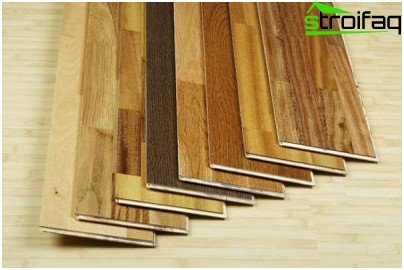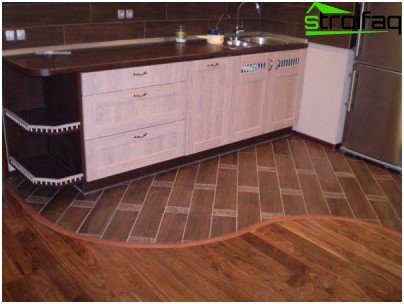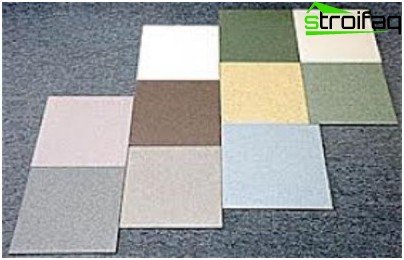To make the right choice among all the abundance of flooring is quite a difficult task, and everyone chooses what is more familiar and familiar. Today, there are materials that in their structure and characteristics resemble wood or natural stone, but created artificially using natural raw materials. The most prominent representatives of this category of flooring are laminate and tile. When choosing a particular material, the question often arises – which is better: tile or laminate? To answer it, you need to consider all the advantages and disadvantages of each of these materials and know in which room they will be able to best show their strengths.
Content
- Advantages and disadvantages of floor tiles
- Advantages and disadvantages of laminate flooring
Advantages and disadvantages of floor tiles
Ceramic tiles are perfect for bath, toilet and hallway
This type of flooring has been popular for many years, even centuries, and it continues to grow..
To operational benefits Floor tiles include:
- Wear resistance and durability. The tile can last 50 years or more, and the level of durability allows it to be laid in rooms with high loads on the floor surface.
- Durable and undemanding material. Tile refers to those materials that “put and forget.” Caring for it is the simplest and does not require the use of special tools or cleaning methods. The surface of the tile is difficult to damage or scratch, and if you don’t drop anything heavy on it, the tile can withstand quite large loads.
- A wide selection of colors, textures and patterns. Today, technology allows you to make very high-quality simulations for various materials with diverse patterns. The color range of tiles is very wide, you can choose for every taste.
- Environmentally friendly material. For the production of tiles, only natural raw materials are used..
- High moisture resistance. Due to the specially processed glazed surface, the tile flooring does not absorb water well, which is very useful for the kitchen, bathroom and toilet.
- Not subject to fire and rot..
For an objective assessment, it is necessary to note the disadvantages of ceramic tiles:
- High thermal conductivity of the material. Tiles, like natural stone, are cold material. For additional heating, you can install a “warm floor” system. But there is a positive point in this “minus”. Floor tiles perfect for hot climates.
- The difficulty of laying. Today, special glue is used for laying tiles, which greatly simplified the process, but this did not affect the overall progress of the work. Tiles still require high handling skills and increased attention during installation.
- A lot of weight. The tile coating has a very large mass, which affects the requirements for the base. It must be as reliable and capable of withstanding heavy loads..
- The fragility of the coating. This lack of tile is not so noticeable on strong concrete substrates. In addition, the tile has a special strength marking on the Mohs scale from 1 (talc) to 10 (diamond). But on wooden or poorly prepared substrates with indentations or other flaws, the tile floor may crack or crack over time..
- Slippery surface. If moisture gets on the surface of the tile, it can slip and fall. In fairness, it should be noted that manufacturers have succeeded in creating various non-slip surfaces. Therefore, when choosing, you should pay attention to this parameter.
Floor tiles can be laid in almost all rooms: bedrooms, kitchens, dining rooms, hallways, corridors, bathrooms and toilets. When laying tiles, you should remember about its high thermal conductivity, surface topography and level of strength. These three parameters will determine in which room to lay this or that tile.

Advantages and disadvantages of laminate flooring
Laminate is suitable for the kitchen, bedroom, hallway and common hall
Invented at the end of the century, the laminate quickly conquered the market for flooring and today occupies a leading position.
Laminate has a number of characteristic advantages that distinguish it from other floor coverings:
- Easy styling. Thanks to the locking method of fixing the laminate, all the laying work can be done alone with minimal time.
- Good heat and noise insulation properties. But it should be noted that high performance is achieved not due to the laminate itself, but due to the presence of a substrate of cork, polyethylene foam or expanded polystyrene.
- A wide selection of colors and patterns. The surface of the laminate is made in such a way that allows you to simulate almost any natural material, and can be made in any color. Although in practice the laminate is somewhat inferior to the floor tile in the number of colors and patterns.
- Good resistance to abrasion and household chemicals. It should be noted that, like tiles, the laminate has a certain marking according to the degree of load and resistance to abrasion. More accurate data are given in the table:

Table number 1. Indicators of wear resistance and degree of load of the laminate
- Light weight. Due to this, the laminate can be laid on various types of substrates and reduce the load on them, which in turn reduces the cost of their preparation.
- Ecologicaly clean. This parameter is somewhat controversial, since the laminate surface is made of plastic, but its performance fully meets all environmental standards and hygiene requirements. Pressed wood is used to manufacture the panel itself..
- Affordable price.
Of the disadvantages of the laminate, it is worth noting the following:
- Low moisture resistance. Despite the fact that manufacturers have created a waterproof laminate, its ability to tolerate high humidity is very low. Because of this, it is not recommended to lay the laminate in the bathroom, kitchen or toilet.
- Low sound insulation. Since the surface of the laminate is made of plastic, any hard object falling on it or the hard sole of the shoe will make an unexpectedly loud sound.
- High base requirements. Despite its low weight, the laminate has very stringent requirements for the base. Therefore, before laying it will have to carry out a number of serious preparatory work.
- Squeaks of connected panels. Laminate joints with improperly prepared base and non-compliance with installation technology can produce unpleasant squeaks.
- Specialized cleaning products. Since the laminate is “afraid” of water, its cleaning requires the use of certain cleaning agents and methods, which is not always convenient.
- Short service life. In comparison with a tile, the service life of a laminate does not exceed 25 years.

Laminate and tile can be laid in one room, breaking it in such a way into zones
The laminate is perfect for such rooms: a bedroom, a nursery, an entrance hall. Controversial are the corridor, bathroom, kitchen, toilet. When laying a laminate, it is necessary to take into account the humidity level in the rooms and, if possible, lay it in drier rooms.
Laminate and floor tiles can be stacked at the same time. The coating obtained in such a simple way will be very original. In addition, with this approach you can distinguish between certain areas of the room, which will allow more rational use of the strengths of tile and laminate.







